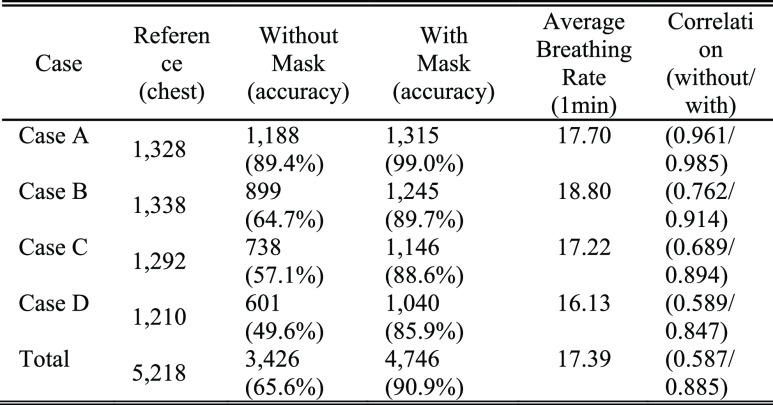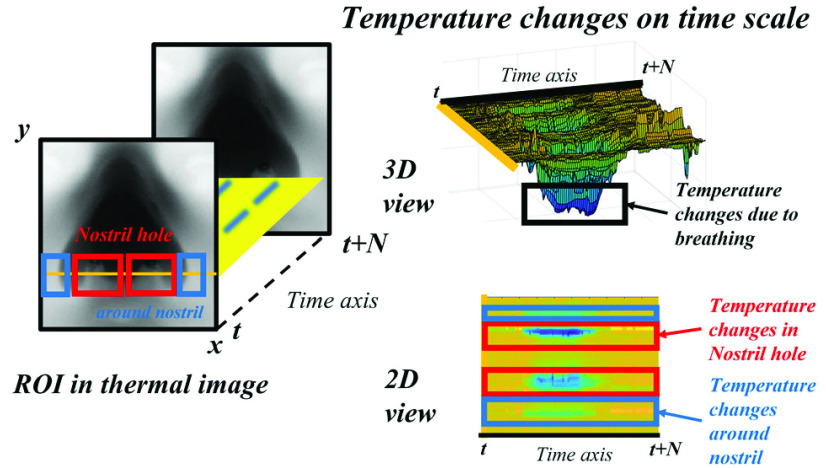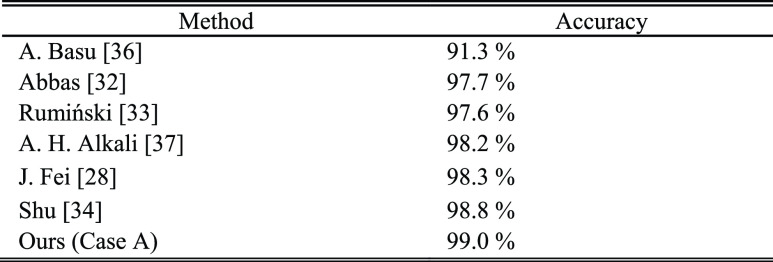用于基于热像仪的间接呼吸监测的呼吸相关面部区域分割。
IF 3.7
3区 医学
Q2 ENGINEERING, BIOMEDICAL
IEEE Journal of Translational Engineering in Health and Medicine-Jtehm
Pub Date : 2023-07-17
DOI:10.1109/JTEHM.2023.3295775
引用次数: 1
摘要
可以使用热像仪以非接触方式测量呼吸。这项研究的目的是研究使用热像仪进行的非接触式呼吸测量,此前热像仪仅限于从鼻孔清晰可见的前部测量鼻孔。前面的方法很难用于其他角度和正面视图,因为鼻孔没有很好地表现出来。在本文中,我们定义了一个新的区域,称为呼吸相关面部区域(BAFR),它反映了呼吸的生理特征,并从45度和90度的视图中提取呼吸信号,包括鼻孔不清晰可见的正面视图。对15名健康受试者进行了不同视角的实验,包括有鼻孔和无鼻孔的正面、45度和90度视角。使用热敏相机(A655sc型号,FLIR系统)进行非接触式测量,并使用biopac(MP150,biopac-systems-Inc)作为胸部呼吸参考。结果表明,该算法可以从不同角度和视角提取稳定的呼吸信号,应用时平均呼吸周期准确率为90.9%,而没有该算法时平均呼吸循环准确率为65.6%。平均相关值从0.587增加到0.885。所提出的算法可以在各种环境中进行监测,并从不同的角度和视图提取BAFR。本文章由计算机程序翻译,如有差异,请以英文原文为准。



Breathing-Associated Facial Region Segmentation for Thermal Camera-Based Indirect Breathing Monitoring
Breathing can be measured in a non-contact method using a thermal camera. The objective of this study investigates non-contact breathing measurements using thermal cameras, which have previously been limited to measuring the nostril only from the front where it is clearly visible. The previous method is challenging to use for other angles and frontal views, where the nostril is not well-represented. In this paper, we defined a new region called the breathing-associated-facial-region (BAFR) that reflects the physiological characteristics of breathing, and extract breathing signals from views of 45 and 90 degrees, including the frontal view where the nostril is not clearly visible. Experiments were conducted on fifteen healthy subjects in different views, including frontal with and without nostril, 45-degree, and 90-degree views. A thermal camera (A655sc model, FLIR systems) was used for non-contact measurement, and biopac (MP150, Biopac-systems-Inc) was used as a chest breathing reference. The results showed that the proposed algorithm could extract stable breathing signals at various angles and views, achieving an average breathing cycle accuracy of 90.9% when applied compared to 65.6% without proposed algorithm. The average correlation value increases from 0.587 to 0.885. The proposed algorithm can be monitored in a variety of environments and extract the BAFR at diverse angles and views.
求助全文
通过发布文献求助,成功后即可免费获取论文全文。
去求助
来源期刊

IEEE Journal of Translational Engineering in Health and Medicine-Jtehm
Engineering-Biomedical Engineering
CiteScore
7.40
自引率
2.90%
发文量
65
审稿时长
27 weeks
期刊介绍:
The IEEE Journal of Translational Engineering in Health and Medicine is an open access product that bridges the engineering and clinical worlds, focusing on detailed descriptions of advanced technical solutions to a clinical need along with clinical results and healthcare relevance. The journal provides a platform for state-of-the-art technology directions in the interdisciplinary field of biomedical engineering, embracing engineering, life sciences and medicine. A unique aspect of the journal is its ability to foster a collaboration between physicians and engineers for presenting broad and compelling real world technological and engineering solutions that can be implemented in the interest of improving quality of patient care and treatment outcomes, thereby reducing costs and improving efficiency. The journal provides an active forum for clinical research and relevant state-of the-art technology for members of all the IEEE societies that have an interest in biomedical engineering as well as reaching out directly to physicians and the medical community through the American Medical Association (AMA) and other clinical societies. The scope of the journal includes, but is not limited, to topics on: Medical devices, healthcare delivery systems, global healthcare initiatives, and ICT based services; Technological relevance to healthcare cost reduction; Technology affecting healthcare management, decision-making, and policy; Advanced technical work that is applied to solving specific clinical needs.
 求助内容:
求助内容: 应助结果提醒方式:
应助结果提醒方式:


